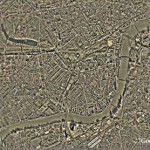I am lazy in the sun of Bulgarian Sozopol holding an enormous book in my hands. A big book one can display on any beach or which could serve to support an umbrella just as well. In this book, “Cities, Architecture and Society”, Dejan Sudjic speaks about the accents of a town, as if we talking about the accents in a language. Accent is an essential part of someone’s identity, something deeply anchored in awell localized collective mind and hints to a personal history of the individual.
Sudjic does not speak of the accents of the town in terms of height accents, therefore not about office tower buildings or about any other monument, but rather about less extraordinary things that are out of scale, but which really give the identity of a town. In the end, office tower buildings are the same all over the world, they are leveled, they meet the average expectations.
According to him, the local accent resides rather in the form of ownership over the land, in the manner in which, throughout history, it has been divided and split, then built, in the manner in which the wealth is distributed in the town. Just in the same manner, the accent is found in the dwelling density, in the color of the taxi cars or in the history of subway lines.
Dejan Sudjic tells the story of how he learned the BBC British accent by listening to the lessons for immigrants on the radio, starting at a very young age because his parents would not speak English in the house. And just as the language is inherited or learned with a local accent, it is precisely in the same manner, he says, that the town onelives in, imprints in one’s mind the first type of spatial organization helping one recognize other places as being towns. His first mental map is London cut through by the river Thames, a map which of course he cannot reuse but which always gives his a starting point when he goes searching in another place: there is a river or not, and if so, what is the south side from it.
In the afternoon sun, I sometimes close my eyes and I remember the empty beach in Mamaia-Sat village a few years ago, the favorite place of Arhitectura editorial staff to recharge their batteries. The way to the beach through faded grass, lined up children singing nursery rimes, albatrosses like napkins, the Navodari towers on the background … poetical. Sometimes we would even go there in springtime or even in winter to see the place again, because it is slowly disappearing suffocated by tourist Mamaia. I can understand this search for your river Thames in any town, the search for the south you lived in.
I’m done, it’s ice-cream time.


